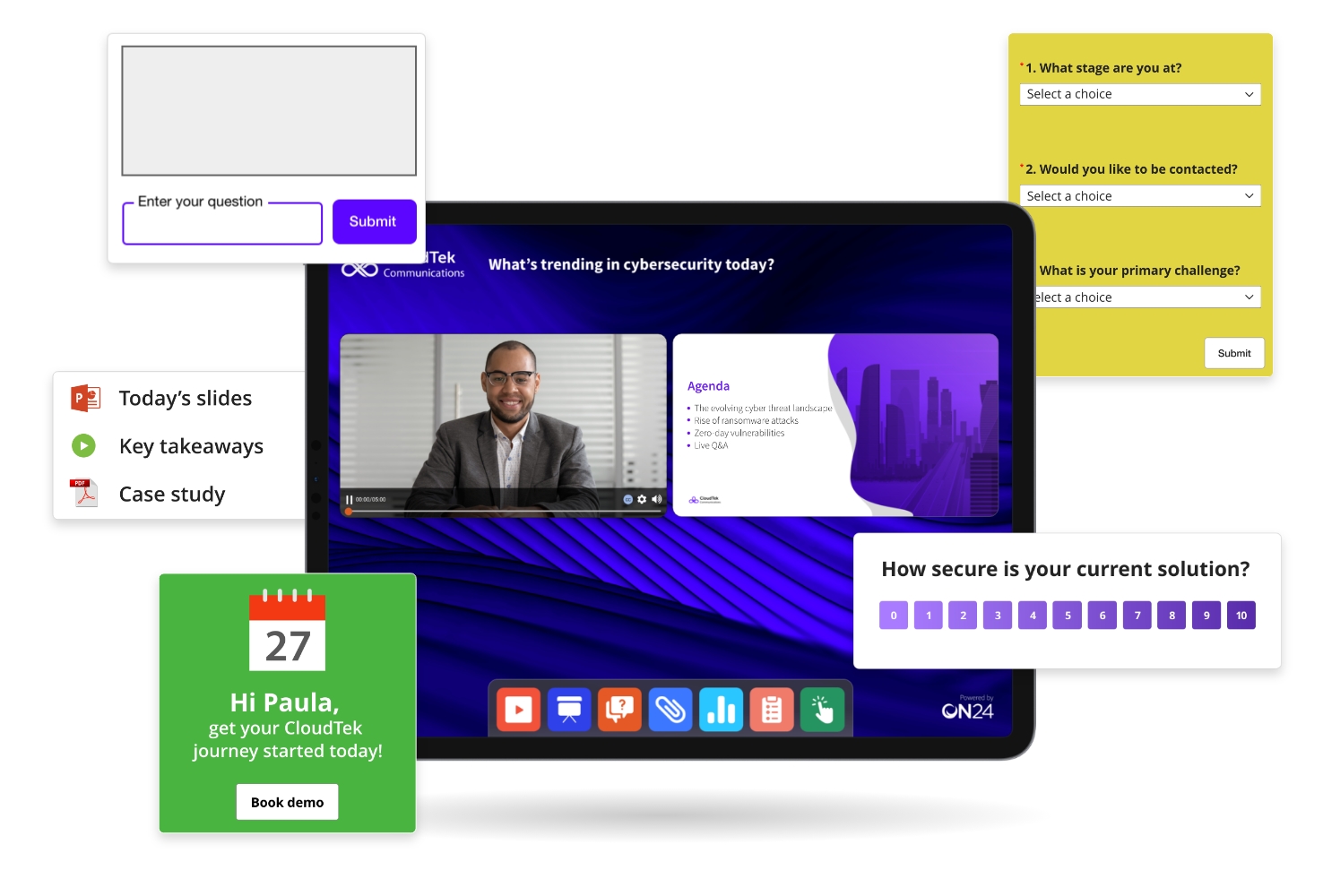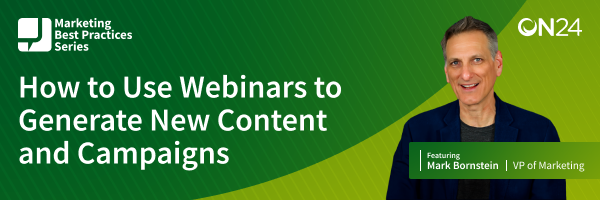Businesses face a multitude of challenges: reducing costs, increasing revenue, and striving to be the most efficient organization possible. For marketers, this challenge typically manifests in the phrase “do more with less.”
And the pressure to meet this challenge — and prove ROI — is high. In fact, according to a 2023 Anteriad survey, 41% of marketers say the pressure to prove the overall value of their efforts is “overwhelming.” Another 14% say it makes them want to pull their hair out.
That’s where content repurposing comes in. With the right content repurposing strategy, a small, nimble team can transform events like webinars into fully fledged campaigns in a matter of days. Not only that, but they can use the insights they’ve gleaned from their engagements to further segment and personalize outreach while propelling pipeline.
Let’s take a look at how.
Why Content Repurposing is Essential

Content repurposing saves time, conserves resources, and increases the content’s lifespan. It’s also a great way to align content, whether inbound or outbound, with campaign messaging.
A well-thought-out content repurposing strategy will:
Increase the value and longevity of your content – Content repurposing extends the lifespan of your content by providing multiple opportunities for it to be discovered over time, thereby helping to engage audiences and attract new followers.
Enhance your company’s reach and visibility – No two audience members share the exact same content preferences. Some visitors may like to get their information from blog posts and e-books. Others may prefer videos and podcasts. Content repurposing can help you cater to a diverse audience.
Reinforce your key messages and keep your brand front of mind – Rather than approaching content with a “one and done” mentality, repurposing ensures your core messaging and brand values are consistently communicated across different platforms and formats.
Enable you to adapt to audience preferences and trends – The way in which audiences and brands interact with one another is constantly evolving. Repurposing content, such as clipping short videos from events, enables you to stay up-to-date with trends and consumption habits, ensuring that what you’re putting out there remains relevant.
Boost your online presence – Repurposed content can enhance your website’s search engine optimization (SEO) efforts by helping your content rank for keywords relevant to your business. For example, turning a video into a blog post with optimized titles and descriptions can enhance your visibility on both search engines like Google and video-specific platforms like YouTube.
Why Webinars are Central to a Content Repurposing Strategy

Content repurposing strategies require one thing: seed content. That’s the primary asset from which repurposed content derives. Often, this will be a big report, e-book, or webinar that’s the center of a campaign strategy.
However, some content formats are better suited for content repurposing than others. The best format is usually a webinar.
With webinars, marketers can:
-
- Create transcripts and automate the production of blog, e-book, and key summaries.
- Identify key sections from a webinar and extract short video clips for sharing on social media.
- Collect first-party data that can be used to segment and personalize digital experiences and content for audiences.
But putting webinars at the center of a content repurposing strategy requires a shift in mindset. B2B marketers need to move away from the “one-and-done” mentality and adopt interactive digital events, such as webinars and virtual events.
Another hurdle is having clearly defined roles and responsibilities for how team members will create and repurpose this seed content. This is especially true when teams — who are tasked with “doing more with less” — are short-staffed. Having roles clearly defined can help even the most minor team scale post-event activity.
Finally, one of the most significant hurdles to overcome is the challenge of repurposing content on a broad scale. That is, only repurposing content for a general audience rather than segmenting and targeting key audiences based on actionable data collected from webinars. This is a huge missed opportunity for marketers, as the first-party data collected from webinars lends itself to making segmentation and personalization much easier at scale — especially when generative AI marketing tools can help accelerate production.
The Four Building Blocks of Webinar Content Repurposing

Happily, putting webinars at the center of a content repurposing strategy is simple. All that is necessary is to break your process down into manageable parts. Consider the four building blocks of webinar content repurposing:
-
- Goals
- Audience
- Content Types
- Channel
Setting Goals
The first step in creating a content repurposing strategy is identifying what you want to accomplish. Do you want to boost brand awareness? Educate audiences on a product release? Engage specific audiences, like verticals or even a high-value account?
Create a list of goals you’d like to accomplish and then categorize them into tactical and strategic goals. Below are two examples of what that may look like:
Tactical:
-
- Capturing new perspectives and content for future use (Think: evergreen content)
- Building a library of actionable content
- Saving (or reducing) time, money, and other resources
- Increasing the value of content teams
Strategic:
-
- Increasing the reach of original content
- Integrating content into additional channels
- Turning webinars into broader campaigns
- Leveraging webinar content in unique ways for target audiences
- Informing future campaigns
Identifying Audiences
Webinars are a great way to collect and analyze first-party data, which can be quickly used to drive first-party engagement and propel marketing pipeline. In combination with demographic and firmographic data, this information can be used to identify, segment, and personalize content for specific audiences.
Determining Content Types
Seed content can be transformed into many different content types. However, some assets lend themselves to different formats more effectively than others. For example, a webinar diving into a technical demo could be repurposed into a one-pager or a product “how-to” guide. Likewise, high-level events discussing industry trends could be used to produce thought leadership blogs and e-books.
Determining what content should be produced, then, is dependent on the seed content you’re using and the audience you’re trying to connect with.
Determining Channels
Finally, there’s distribution. How exactly will you get repurposed content into the hands of the right audience? Determining which channel should promote which content is essentially the function of knowing who you’re trying to reach with what content you’ve created.
The table below provides you with an example of how you can publish repurposed content with a purpose:
| Content Type | Content Stage | Personalized? | Channel |
| Promotional copy | Top of Funnel | No | Email and Social Media |
| Blog | Bottom of Funnel | Yes | Content Hubs, Nurture Pages, Newsletters, Segmented Email |
| E-books | Top of Funnel | No | Webinars, Landing Pages, Content Hubs |
| Video | Bottom of Funnel | Yes | Webinars, Personalized Landing Pages, Content Hubs |
How to Repurpose Webinars Into Campaign Content Quickly

Implementing the four building blocks — identifying goals, segmenting audiences, developing content, and distributing across channels — may seem like a lot, but modern tools make this process much easier. This is particularly true of generative AI.
While AI cannot do everything perfectly, it can help you drastically accelerate content production. AI tools can help manage the grunt work, like creating drafts, while content creators like you refine assets before publication.
One way of approaching AI in your content repurposing strategy is to remember the Four Rs:
-
- Reuse – Host a webinar on-demand and replay it for audiences on their own terms
- Reformat – Turn a webinar into an e-book
- Remake – Create short videos from webinar clips
- Refine – Use a webinar poll to create new content based on audience feedback
Why ON24 ACE Is A Force Multiplier

Some tools stand apart from others. Typically, for B2B marketers, these tools are platforms that integrate into your tech stack and workflow to help your team become a force multiplier.
Before a webinar
Let’s say you want to identify high-value accounts in a vertical you’re trying to break into. To achieve this, your team creates a high-level webinar tailored for a general audience within that industry.
Now, you could cast a wide net with promotions and hope to catch the interest of a few valuable contacts over time. Or, you could accelerate interest and propel pipeline through personalization and segmentation right from the start with the ON24 Intelligent Engagement Platform.
Using tools powered by the ON24 Platform’s AI-powered Analytics and Content Engine (ACE), like Segment Builder and SmartText, you can target segments through firmographic data and scale promotions to each segment.
Not only that, but you can personalize the webinar experience to specific audience segments as well. For example, from one webinar, you can produce experiences targeting attendees by buying stage, job function, industry, relationship, geography, business interest, and more.
In our example, our webinar can now target business leaders and practitioners by buying stage and company size. Now, instead of one webinar, we have several different experiences filled with custom CTAs and downloadable resources. We can even push surveys segmented to each audience to get a better understanding of their pain points and interests.
After a webinar
After the event concludes, your team and ON24’s ACE make content repurposing a reality. ACE can automate the creation of transcripts, blogs, e-books, key summaries, and social content, which can then be edited, personalized, and used for promotion and nurturing to each segment.
For example, with ACE and the ON24 Intelligent Engagement Platform, you can quickly stand up specialized post-event landing pages. These pages can be filled with relevant written content, CTAs for other events or offers, videos, and the on-demand webinar itself. And you can reproduce this type of landing page across regions, use cases, personas, and buying stages in a matter of days.
Now, instead of a one-off webinar, you have a fully fledged marketing campaign that’s personalized to the audience you’re trying to engage with. And, once they engage with your content, you can get even more first-party data that can lead to more first-party engagement and propel pipeline.
Why You Need a Content Repurposing Framework

By now, you probably have a good grasp of what it takes to repurpose content. The most successful marketers, however, take a systematic approach to content repurposing.
Let’s take a closer look at how to develop a custom content repurposing framework that can be understood and followed by everyone in your organization.
Framework components
Leverage your content to its fullest potential by making sure your content repurposing framework contains the following elements:
A comprehensive content audit
Inventory your existing content and catalog it by type and topic. We recommend using a content management system (CMS) to do this, rather than a simple spreadsheet. Then, once you know what you’ve got and where it lives, identify your evergreen pieces — i.e., the assets that will remain relevant over time — and dive into their performance online by analyzing metrics like traffic, engagement, conversions and social shares. High-performing content is likely to do well a second time around, so this should be your priority.
A carefully considered content map
Map content types to specific formats. For example, a data-rich blog post might be well-suited for an infographic, while a 5,000-word whitepaper could be broken down into a series of blog posts, social media updates and videos.
At this stage, you’ll also need to consider what type of content is likely to be well-received by your target audience and which platform it should be shared on for the most engagement. Creating a content map that works takes some time, but it’s well worth the effort.
Clear goals and timelines
Keep your content repurposing strategy on track by creating a schedule that outlines what needs to be done and when. Make sure it’s clear which member of staff or contractor is responsible for each part of the process and give them deadlines so production runs smoothly.
You should also set key performance indicators (KPIs) for each piece, so you know which data needs to be tracked for an accurate picture of how hard that content is working for your business. Perhaps generating higher volumes of website traffic is important to you, or you’re more interested in getting likes and shares on Instagram or LinkedIn. Either way, make a note of the information that needs to be tracked post-launch.
Establishing specific, measurable goals for your content can encourage everyone to work towards a wider objective, too. For example, you might want to increase traffic to your blog by 20% within three months or generate 10 conversions via your website’s content that can be directly attributed to your content repurposing plan within a timeframe of six months.
Less bottleneck, more bandwidth – and better performance

A content repurposing strategy is critical to any marketer tasked with “doing more with less.” However, effective content repurposing requires combining content format and availability with what your audience is looking for.
That means being empowered to drive engagement, glean insights, and take action at scale. The ON24 Intelligent Engagement Platform and ON24 ACE, along with other tools in your tech stack, enable you to do exactly that.
With the right content repurposing strategy in place, you can eliminate the content production bottleneck, provide your team with more bandwidth to take impactful action, and drive better performance and pipeline growth through direct engagement with your audience.
If you’d like to see how ON24 can help you propel pipeline through first-party engagement and content repurposing, click here.





